The Portland Bureau of Transportation has taken a notable step forward in their embrace of micromobility. For the first time since they began annual bike counts in the 1990s, PBOT and their team of volunteers will also tally the number of electric scooters, skateboarders and one-wheelers that roll past the over 300 count locations this summer. Also this year, they plan to make their first attempt at segmenting out the number of electric bikes on our roads.
PBOT has done annual bike counts longer than any other major city in America. Their dataset includes counts from before the year 2000 and has given planners and advocates and invaluable resource to gauge progress and glean insights. This year’s count will likely be scrutinized more than usual. That’s because last year’s count exposed a major cycling decline since 2019 and things in the transportation world have been very topsy-turvy since Covid hit in 2020. “The 2023 counts will be an important measure to see if and how Portlanders are responding to new commutes, new infrastructure, and a new normal,” reads PBOT’s website.
“Without any real data, you just have no voice.”
– Cory Poole, NW Skate Coalition
We’ll also gain a better understanding of the impact these new micromobility vehicles are having on our transportation system. Back in April we shared how e-scooter ridership was very healthy in Portland — even as bike counts dwindled. Are scooters, electric skateboards, and one-wheels luring people off their bikes? Are their enough of these users to demand a greater voice in infrastructure planning and policy decisions?
Cory Poole with Northwest Skate Coalition hopes so. He’s happy PBOT will get more serious about counting more than just bikes. In a phone call today, Poole reminded me that PBOT counted skateboards back in 2014, but that effort wasn’t very robust and it only lasted three years. He thinks having better data about how many people are using scooters and skateboards (he’s even noticed a big uptick in roller skaters), will give these modes a bigger seat at the table. “People are choosing a much wider range of modes to get around, and without data, you can anecdotally say, ‘Oh, I see skateboards all the time, or ‘I see scooters all the time.’ But without data, it’s really hard to put that into any kind of useful narrative, especially if you’re asking the city for money.”
“Without any real data, you just have no voice.”
Right now, Poole says, skateboarders and scooter-riders are not represented on an of PBOT’s three modal advisory committees — which specifically represent the interests of bicycle, pedestrian and freight advocates. “Hopefully, if they can see that a certain percentage of people out there are skating, scooting, and roller-skating around, that there should be some voice voice at the table.”
What would an advocate like Poole do with a stronger voice? He’d push for smoother pavement, smaller expansion joints on bridges, and lane markings that don’t make skateboarders slip.
This new approach from PBOT will also hasten awareness and evolution that “bike lanes” of the future might intentionally welcome more than just bikes. As we shared back in March, there’s been a push from some urban planners to re-frame bike lanes and be more inclusive of a wider range of lightweight vehicles that aren’t ready to mix with car drivers, but are not typically considered as bike lane users.
PBOT signs up and trains dozens of volunteers for their counts each year. They will fan out to over 300 locations citywide and counts will begin June 6th and run through September 28th. Sign up to help and learn more about the counts on PBOT’s website.



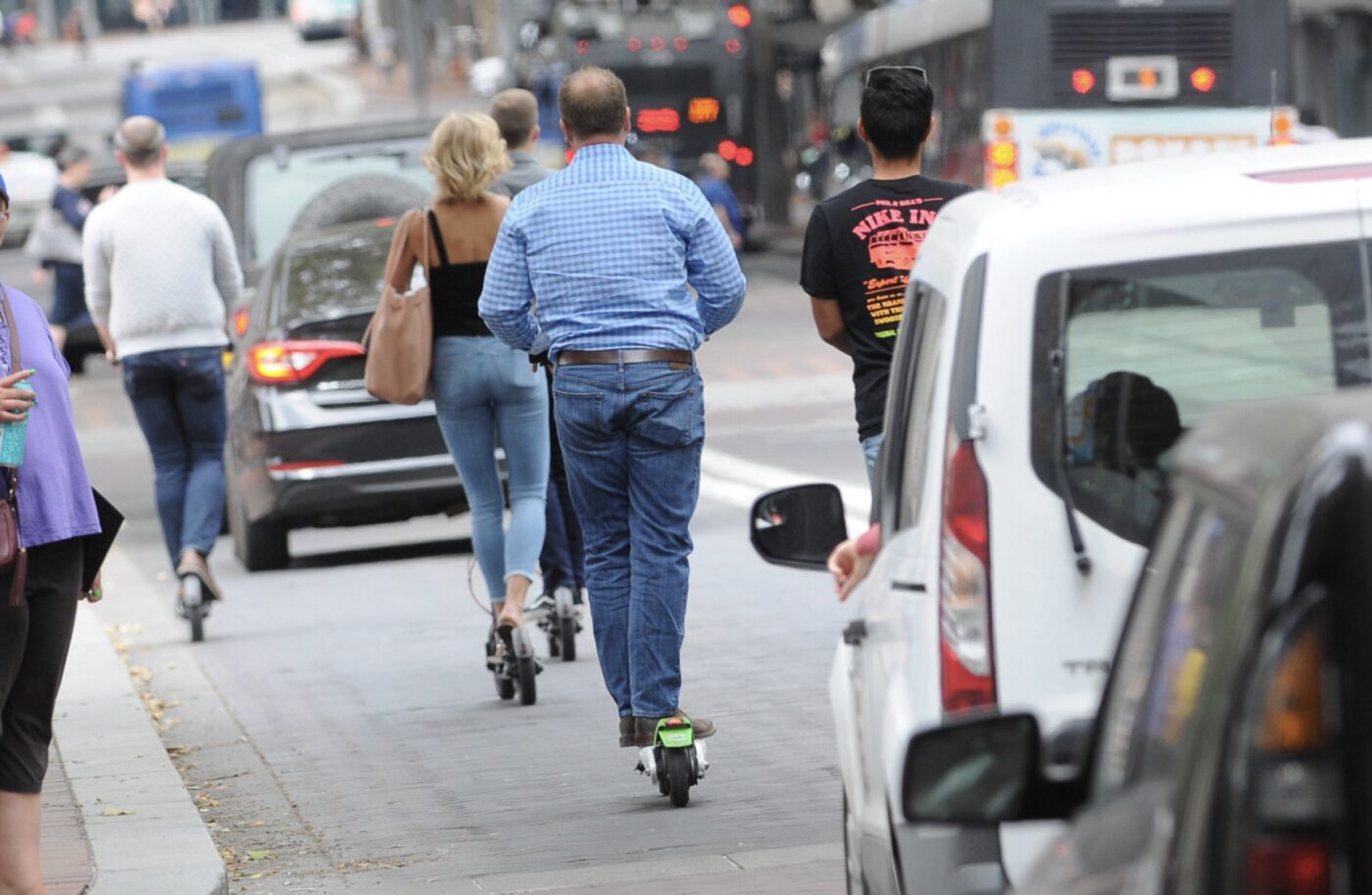
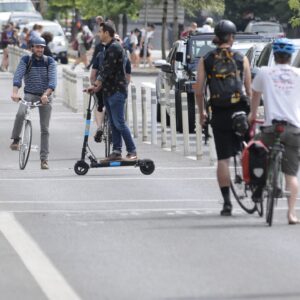
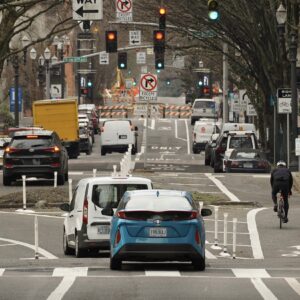
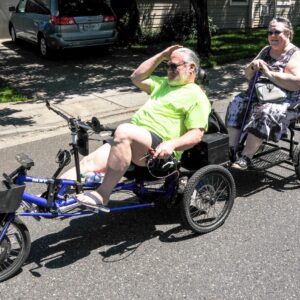
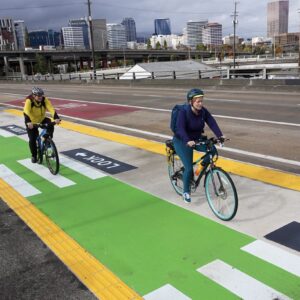
Thanks for reading.
BikePortland has served this community with independent community journalism since 2005. We rely on subscriptions from readers like you to survive. Your financial support is vital in keeping this valuable resource alive and well.
Please subscribe today to strengthen and expand our work.
So to compensate for the fact that no one is riding bikes anymore they have to juice up the numbers with other transportation modes?
Is that basically the reason?
Since the bike lanes are empty I guess they might as well fill up with scooters but I do wish the scooter people would stop leaving them horizontal to
bike racks at my local Freddie’s……
Scooter people and bike people have very little in common, I am not sure why they are always lumped together.
“Scooter people and bike people have very little in common, I am not sure why they are always lumped together.”
You mean other than being people going from A to B without burning gasoline and not surrounded by many pounds of steel?
I do not run and have never been a runner. Just because I use no gas doesn’t make me and someone who runs a marathon similar.
The same with someone riding a scooter.
Completely different transportation modes.
Are people who don’t drive but take Light rail the same as car drivers?
Do they have anything in common?
I think pedestrians and cyclists have completely different needs and infrastructure. Bikes and walking are not the same at all.
I would say that bikes and scooters are similar in the same way that light rail and buses are similar. They are different in some superficial and some concrete ways but many of the needed affordances (right of way, sheltered stops, fare collection) are the same between buses and light rail. Similarly, bikes and scooters have many similar needs in transportation infrastructure even though they are not exactly the same.
tell that to the gas burning trucks I encounter parked in the biek lane dropping off/picking up scooters!
Or maybe just maybe people weren’t using those types of vehicles 10 or even 5 years ago and now that so many are and using them on greenways and in bike lanes it makes sense to count them.
How about roller skates, too?
a long time ago in a city far away …..
one of my recumbent buddies was riding a “bike” trail when he heard an odd sound approaching from behind:
Whooosh – thump, whoooosh – thump
Glancing in his mirror he saw a guy on inline skates overtaking him.
Now, he was no slouch and was going at a decent clip so he was more than a bit surprised – until the skater overtook him and he recognized him as Apolo Ono out training.
Fits in a bike lane, not much weight (say rider+75lbs or so as an upper limit) not overpowered – we all have a lot more in common than differences.
Just the riders of faster/heavier vehicles have a duty of care when overtaking the lighter ones IMO (e-bikes and velomobiles are what I’m thinking of here).
I love Cory Poole’s suggestions, I think they would make our network better for all users! Getting mores in the advisory group seems like a good idea.
I would hate to see PBOT cave so quickly and cede the bike lanes to electric vehicles. The motor vehicle network is already beyond complete, there are multiple redundant routes to drive anywhere and vast network of parking whereas the bike network is underbuilt, disconnected, lacks parking, etc. PBOT should take look at how they are managing the CAR network to create routes that people on electric vehicles would feel more comfortable using. Instead of just cramming increasing disparate types of vehicles into our narrow, disconnected bike routes, PBOT should take a look at correcting some of their transportation management failures to create a safer, more welcoming transportation system.
I’m confused by your comment, do you think that the quote implied introducing cars into the bike infrastructure? To me it sounded like they are simply planning to recognize the reality that the best place in our current infrastructure for scooters, one wheels, etc. is in the bike lane which is where the owners of those vehicles are already riding. They have similar usage patterns to bikes and they’re not in a car, why wouldn’t we want to embrace those riders with open arms? More users of bike infrastructure will increase demand and make it better for all of us.
If your concern is just about the tiny percentage of e-scooters and e-bikes that can accelerate to much higher speeds than bikes, wouldn’t a better solution just be implementing a speed limit for bike lanes? We can all share the bike lanes if we’re traveling at roughly the same speed, it doesn’t matter that someone is standing on a scooter instead of riding a seated bicycle.
Aaron,
I think the quote implies introducing small electric vehicles to the bike network. I do not share your optimism that adding users will inspire PBOT to improve the network. The bike network is underbuilt and disconnected. We are possibly seeing a paradigm shift, and it seems really short-sighted to just say that all small vehicles should be relegated to the meager bike lanes and given free range of our parks and paths. Some small electric (and gas) vehicles do operate at similar speeds to bikes, and plenty of others do not. The gist of my comment is to encourage a broader consideration of our entire transportation system. I don’t think a speed limit for bike lanes is really adequate. With cars getting more huge and delivery vehicles becoming ubiquitous, maybe we need to limit vehicle size/power from more streets, to create a network of small cars, and other motorized vehicles that excludes large private and commercial vehicles. Maybe access to bike lanes and paths should be limited by power/class or vehicle. Do you think scooters belong on sidewalks? Do you think one-wheels going 30 mph are appropriate on the waterfront path? Where do gas-powered bikes and longboards fit in?
I encourage regulatory agencies to police bad behavior rather than ban vehicle types. Blanket bans are often abused to target minority groups. ( see skateboard laws )
If we don’t want to see high-speed electric vehicles on our MUPs we can put a speed limit on the trail or a wattage limit on e-assist vehicles.
For many reasons, an E-skate or scoot can be the most practical vehicle for folks. Not everyone has room to store a bike at home, school, or work. E-boards and small E-scoots also work better on public transit for a last-mile solution.
Should we also cap speed for people on road bikes while we are at it?
I’ve had some riders fly by me on the springwater pushing 30mph.
Road bike brakes don’t work very well at those speeds.
I agree with you Cory P- high speeds don’t belong on recreational spaces. The springwater is a horrible place to take a walk with a kid or dog because rude cyclists ride inappropriately fast on it. ITs a shame, because we need paths along the river and in natural space for people to walk and explore AND we need paths and safe place for people to use as safe, alternative transportation and for active recreation. So I think capping speeds for all modes is good idea, and creating sow, safe places where people can walk with a kid or a dog and not worry about getting clipped by someone going 20+mph. In general, Portland does a very poor job of designing those- the Esplanades is supposed to be a bike route and a place to have a picnic with your family- not 100&% inconsistent, but some careful design is required to make sure it functions for all users. With increasing numbers of motorized small vehicles, the demands on these hybrid recreational spaces is increasing, but the City is not acknowledging it- they keep pushing everyone together into bike lanes, MUP’s, paths in parks,and sidewalks. IMO, this is the time to design a new street classification- maybe this just greenways but they will need to fill in the myriad gaps, and some rules about what types of users can use what spaces. For a City to be a healthy, successful place to live, I think the pedestrian spaces- parks, paths, sidewalks and crosswalks need to be the top priority- make these as safe as possible for as many people as possible- universal accessibility. Bikes, boards, e-vehicles need to fit in around those spaces, to not diminish them- but they need routes and protection, too.
The more I think about this, it just gets worse. They are trying to “other” cycling.
Lumping us in with skate boarders to further diminish cycling as a. transportation mode.
Cycling has Zero in common with Skate boarding. It’s simply a way to make cycling on city streets seem as silly as skate boarding down Sandy boulevard at rush hour.
I don’t know where you’re biking but the number of people I see using long boards motorized or not to get around has increased significantly in recent years. You may not think these other vehicles are the same as bikes but the fact is people are using them for transportation much more frequently now which is what they have in common with cyclists. Also, they’re more similar to bikes especially e-bikes than they are cars. Like they can use the bike lanes and they do use the greenways even if the signage doesn’t apply to them.
Might I gently request that you put a check on your pessimism here dwk. Consider two, more simple reasons imo, for this adjustment. If the count is indiscriminate of non-car/truck users, than it is much more reasonable that this is done to make the data more simple to collect, as volunteers would not need to discern if someone is on a bike specifically. On the other side of the coin, if volunteers are trained to distinguish between bikes, scooters, ebikes, one wheels, skateboarders etc, than the data becomes more comprehensive and as discussed above, will show that the needs of these users must be considered with a more comprehensive lens.
While it is easy to point fingers at PBOT’s track record as justification for negativity (I don’t disagree here), I do think that more data and that ‘juicing up the numbers’ as you said, can have a net benefit as more than just PBOT will have this data. In my first example, rather than just being othered, we may be able to show how many people are not in cars and trucks and need equitable and safe access to our roadways, and how many of them are being used as a legitimate form of transport.
i love skateboarders 🙂 and one-wheelers! unicyclers! anyone being creative and getting around without a car!
I often see more e-scooter users than people biking. Perhaps it’s time to retire exclusionary terms like bike lane or bike infrastructure. It would amuse me if e-scooter counts turned out to be higher than bike counts on some of our mobility lanes.
Me too, especially considering how many e-scooter haters I see pop up every time they are a topic of conversation. I still see way more bicycles in the bike lanes so I don’t think this is going to happen for the ‘23 report but I could see it tipping the scales one day.
Personally, I have an e-scooter which I occasionally ride when my primary vehicle (cargo e-bike) isn’t the right choice and I really don’t see why people want to “other” e-scooters so badly. Sure it doesn’t require any pedaling but it travels at about the same speed and except for the standing position it really isn’t so different from riding an e-bike with the assist turned up.
and its basically every argument people use to attack cyclists. so confusing? scooters are fun. people really really love riding them. this is a good thing!
Aaron, I will only speak for myself: I do not hate e-scoooters, nor do I want to other them. I do want the City to recognize that motorized vehicles are distinct from bikes and understand that there is a range of vehicles available. I do not think that all motorized vehicles belong everywhere. I have shared bike lanes and paths with plenty of e-bike, e-scooter, and e-onewheels. Many are travelling similar to bikes. many others are travelling really fast- 25-35 mph. I don’t motorized vehicles belong in parks. I don’t think 25 mph is an appropriate speed for the Waterfront path. I think the City is missing an opportunity to get in front of this issue, and I think it is a mistake to generally lump bikes together with skateboards, and small motorized vehicles (e-bikes, scooters, onewheels, skateboards, etc)
It’s just a matter of time before e-bikes greatly outnumber non-motorized bikes. The idea that old-fashioned bikes should be given some special status is just another form of retro-grouchery. That being said I personally greatly prefer my muscle-powered bike to my e-bike (I also still use wired headphones, listen to broadcast radio, use paper checks on occasion, and mostly use my phone as a phone).
I get what you’re saying but again none of your objections are things that couldn’t be solved with a speed limit. Calling e-bikes/scooters/etc. with a 20mph speed limit “motorized vehicles” is technically true but I feel like it’s intentionally misleading. Most people associate a “motorized vehicle” with a full-sized automobile, not a tiny two wheeled vehicle that behaves like a bicycle. These lightweight vehicles are in the same class as bicycles (aside from a tiny fraction that are outliers) and they need safety and protection from cars just as much as bicycle riders.
If you truly think these are a separate class of vehicle then do you think that we need to be creating an additional separate network for them or are you arguing that they should be riding their scooters and e-bikes in the car lanes? Personally I think anything that pushes these road users out of the safety of the bike lane is going to reduce ridership further and only further entrench car dependency. Most of those users won’t go buy a pedal power bike and throw away their scooter if they can’t use it in the bike lane, they’d just drive their car instead and add to the problem.
the hatred scooters get is a little absurd. we are one of you. i rode a bike for 15 years in portland and now i ride a scooter bc it takes up less space in my urban condo. the ablism in this discussion a little overwhelming. “they dont work as hard!” its called accessibility!
E-bikes are prolific, so I’m not really sure you can make the charge of ableism in the scooter/bike debate. For many people with limited mobility, an e-bike is more accessible than a scooter that requires balancing while standing up.
I honestly don’t care about scooters, trikes, whatever, as long as they are using the MUP in a safe way. My biggest issues lately have been people on gas dirtbikes and those dorky electric one wheel things going way too fast. If you need a full face helmet for your mode of transit, you probably shouldn’t be on a MUP…
People with autoimmune, inflammatory, musculoskeletal, or neurodegenerative chronic disease can experience pain when moving so in these cases a standing or sitting position without movement can be less painful. As someone with an automimmune disease that attacks joints and tendons, I purchased and used an e-scooter when both cycling and walking became painful. (Thanks to the genetically-modified-organism-produced stuff I inject, my disease is mostly in remission so my e-scooter only gets occasional use lately.)
Remember how PBOT bent over for Lime / Bird / etc. That was a big investment of lobbying $$$$$$ for these venture capital backed startups who were then granted access to park their fleet all over our public owned sidewalks for essentially nothing.
Follow the money.
PBOT has still not accepted a premanent e-scooter agreement with any of these companies but this city instantly approved TNCs (Uber and Lyft) even after they started illegally operating in Portland.
How about a deal. If you agree to ban TNCs (the epitome of venture capital-backed predatory monopolists) I’ll agree to more regulation of e-scooter share.
Hi Jonathan,
I don’t know if you will see this on an old article. I am looking for contact info for Cory Poole. I can’t find a current website for the NW Skate Coalition. Can you help me out?